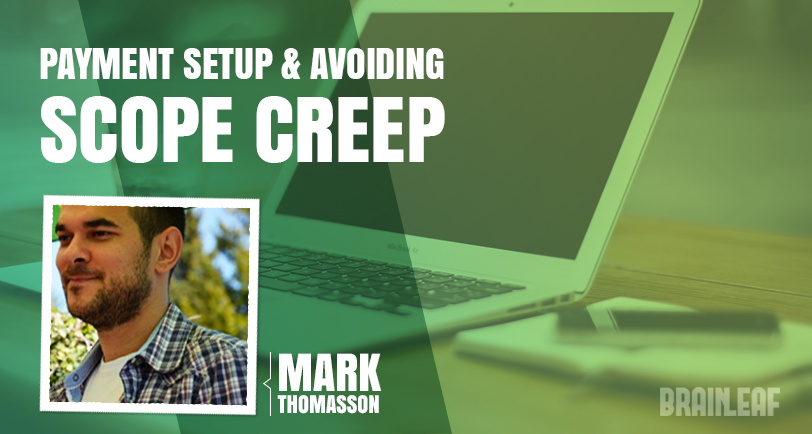
A guest post from biz-dev hero Mark Thomasson
Freelancing comes with plenty of perks and difficulties. Scope creep can be one of the greatest obstacles in the world of a freelancer, and with substantial consequences. When you fall into a situation where your workload for a project exceeds the pre-agreed scope, it can be difficult, or sometimes impossible to charge for your additional work and change the billing schedule.
It’s tempting to jump right into a project, especially when you enjoy what you do,
but setting up a detailed scope before you start a job will help both you and your client understand exactly what to expect from one another. You deserve to get paid for your time and your clients deserve to have all of the details up front. Fortunately, it’s easy to put yourself in a position to get paid for the hours you work and meet your deadlines.
Build a Collaborative Relationship
Have an Honest Conversation With Your Client.
 Don’t simply nod your head along with everything the client says or you run the risk of misunderstanding your their goals, which is how scope creep starts to take hold. The last thing you want is to realize halfway through a project that goals and expectations need to be realigned. When this happens it’s almost certain you’ll end up doing extra work that your client won’t want to pay for, and rightfully so.
Don’t simply nod your head along with everything the client says or you run the risk of misunderstanding your their goals, which is how scope creep starts to take hold. The last thing you want is to realize halfway through a project that goals and expectations need to be realigned. When this happens it’s almost certain you’ll end up doing extra work that your client won’t want to pay for, and rightfully so.
What Does Your Client Really Need?
 Don’t assume your client knows exactly what they want. Ask as many questions as you need to get a clear understanding of the big picture as well as the details. Take an active approach to your projects and discuss the details with your client. It’s up to you to help the client know their options and sort out what they need versus what they say they want. After all, they are relying on your expertise.
Don’t assume your client knows exactly what they want. Ask as many questions as you need to get a clear understanding of the big picture as well as the details. Take an active approach to your projects and discuss the details with your client. It’s up to you to help the client know their options and sort out what they need versus what they say they want. After all, they are relying on your expertise.
When you collaborate with your client, you can formulate a plan that best meets your client’s needs. Sharing your ideas and previous professional experiences will show your client that you’re invested in the success of their project.
Be clear and honest about your knowledge, abilities, and recommendations. By taking an active role in planning the project, you’ll start off your professional relationship on the right foot. On top of that, building trust from the start will make implementing a payment plan much easier.
Planning Out Your Project

SOWhat?
Any experienced freelancer will tell you a scope is crucial. This means writing a detailed scope of work or statement of work commonly known as a SOW. Taking time to sort out all the stages of the project including milestones, deliverables, and detailed billing will be well worth it in the long run. This framework will contain the requirements and the end goals of the project, giving both sides a clear list of their obligations and tasks. On top of that, a good SOW will detail your hours and pricing structure and help set up a payment process.
Everything you need to know about writing a thorough SOW document
Let’s Agree: You Need a Contract
Equally important, is your contract. This may be delivered to your client along with your SOW, or as a separate document. In either case, it’s imperative that you have a clear contract signed by your client to serve as an official agreement on the project terms. Don’t begin work until you have a signed contract or you may end up working for free.
Contract Appendices For Additional Tasks
 It’s in your best interest to include some special contract appendices for potential additional tasks. These amendments should contain a few just-in-case options. For instance, your client may decide to assign some new duties related to the project outside of what was included in the original SOW. When new tasks are added you have a right to charge those separately from the rest of the project and at an appropriate rate. You may want to include your terms for such changes in your original contract so everyone is on the same page before the situation comes up.
It’s in your best interest to include some special contract appendices for potential additional tasks. These amendments should contain a few just-in-case options. For instance, your client may decide to assign some new duties related to the project outside of what was included in the original SOW. When new tasks are added you have a right to charge those separately from the rest of the project and at an appropriate rate. You may want to include your terms for such changes in your original contract so everyone is on the same page before the situation comes up.
Everything you need to know about contracts for website projects.
Planning Out Your Payment
Down Payments
Once you have solid SOW, a good rule of thumb for every online collaboration is to collect a down payment. It could be 10% or any other amount of the total estimated sum for the project. This initial payment is a guarantee that both interested parties are determined to approach that project in a serious manner.
Pre-Arranged Payment Terms
In the online business world, it can be complicated to pursue a legal action against debtors. Avoid stepping onto a financial battlefield by arranging specific payment intervals in advance. For many freelancers, the best solution is to schedule several milestones at which a portion of the total cost is due.
 Of course, it’s important to work with your client to find a payment schedule that is mutually beneficial but be wary of clients who insist on paying the entire cost at the end of the project. Not only does this open the possibility of not getting paid for your work, it can be financially stressful to work for weeks or even months without payment. You may suggest that the client half of the cost the midpoint of the project. A good compromise may be a retainer, in which a client agrees to pay in advance for a certain number of hours of work during the billing cycle. A good client will be willing to negotiate terms that work for both parties.
Of course, it’s important to work with your client to find a payment schedule that is mutually beneficial but be wary of clients who insist on paying the entire cost at the end of the project. Not only does this open the possibility of not getting paid for your work, it can be financially stressful to work for weeks or even months without payment. You may suggest that the client half of the cost the midpoint of the project. A good compromise may be a retainer, in which a client agrees to pay in advance for a certain number of hours of work during the billing cycle. A good client will be willing to negotiate terms that work for both parties.
Billing Schedules and Invoicing
For lengthy projects, may want to bill your client on a pre arranged schedule. For instance, if you know that you deliver your services or products to them on the same date every month, let that date be your invoicing date.
Also, if you’re using a reliable invoicing solution, you can get paid faster. Knowing when you receive your payments will be beneficial to your business plan and make things easy on your accounting person.
Recurring Clients and Special Payment Terms
 Working with recurring clients opens room for special conditions such as discounts for clients that have worked with you in the past or have long-lasting projects.
Working with recurring clients opens room for special conditions such as discounts for clients that have worked with you in the past or have long-lasting projects.
Since recurring clients already have a working relationship with you, they are more likely to agree to pay the entire sum in advance. You can incentivise your clients to pay up front by offering a discounted rate for those who pay the total cost upfront.
Expect the Unexpected
 Clients usually don’t increase the project scope intentionally. Sometimes you just don’t know where a project will take you. So, you need to prepare in advance and consider several possible outcomes for every project. Otherwise, you’ll end up working your tail off while waiting indefinitely to get your payment. Such an arrangement, or lack thereof, might put your entire business effort at risk. Apply our strategies for setting up payment arrangements in line with the project scope to keep clients happy and your business running smoothly.
Clients usually don’t increase the project scope intentionally. Sometimes you just don’t know where a project will take you. So, you need to prepare in advance and consider several possible outcomes for every project. Otherwise, you’ll end up working your tail off while waiting indefinitely to get your payment. Such an arrangement, or lack thereof, might put your entire business effort at risk. Apply our strategies for setting up payment arrangements in line with the project scope to keep clients happy and your business running smoothly.
 Mark Thomasson is a biz-dev hero at Invoicebus – a simple invoicing service that gets your invoices paid faster. He passionately blogs on topics that help small biz owners succeed in their business. He is also a lifelong learner who practices mindfulness and enjoys long walks in nature more than anything else.
Mark Thomasson is a biz-dev hero at Invoicebus – a simple invoicing service that gets your invoices paid faster. He passionately blogs on topics that help small biz owners succeed in their business. He is also a lifelong learner who practices mindfulness and enjoys long walks in nature more than anything else.





